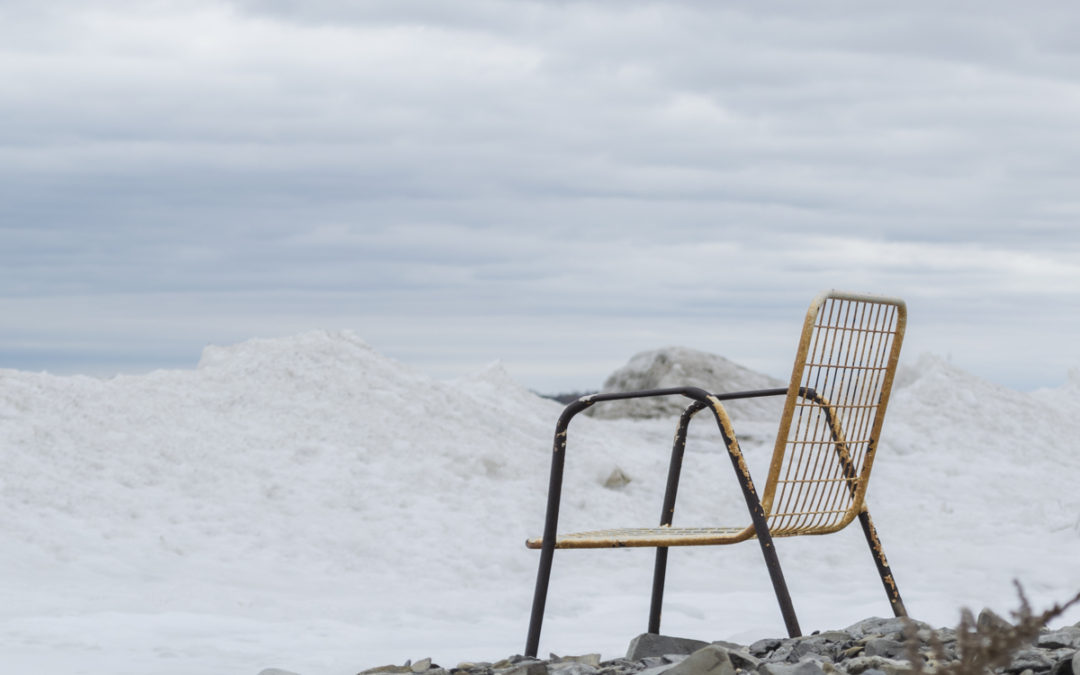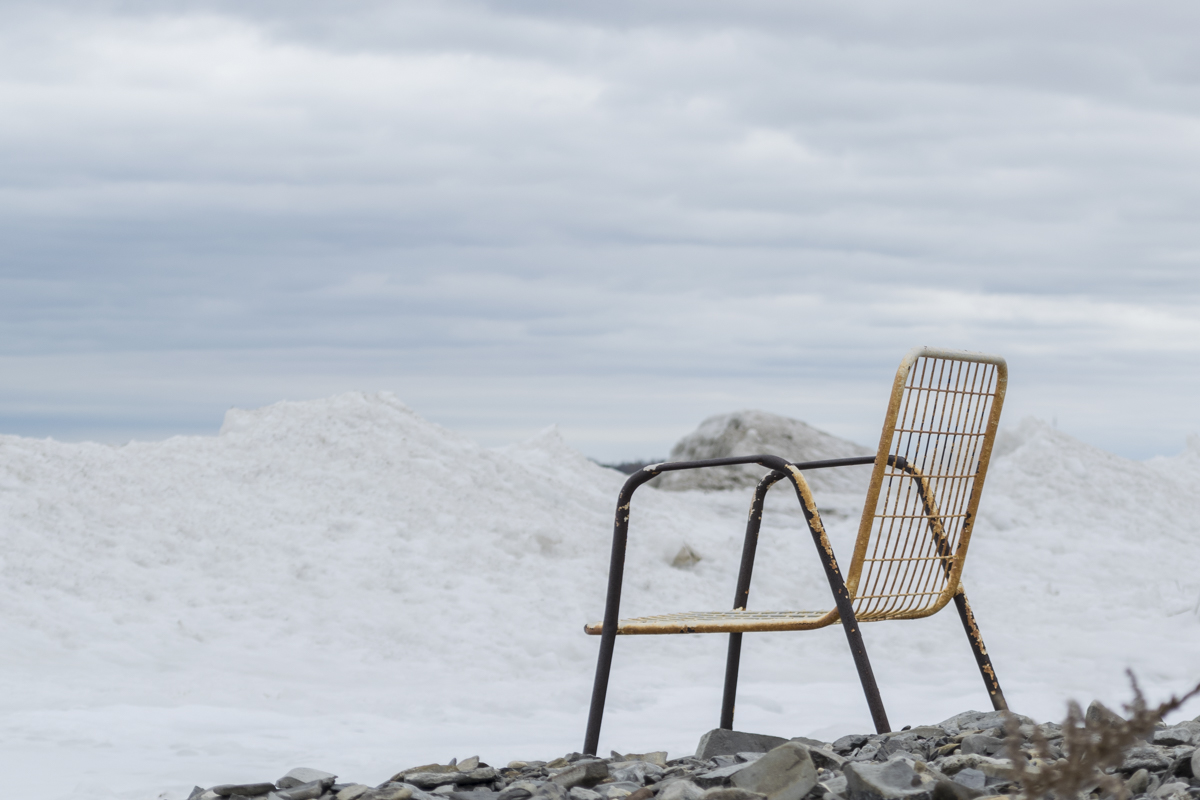What you are about to read are disparate and fictional short stories I have written to coincide with images that are part of a series of photographs of mine entitled “Empty Seats”. The series embraces the enigma of everyday objects that are specifically created by and for human beings, yet they are filled with emptiness, loneliness and a longing for human presence…
Alone and abandoned, the once proud turquoise chair finds itself frozen by the side of the road. Mere hours earlier the chair had enjoyed a life of abandoned inclusion in the warm garage of a lakeside vacation home owned by a caring family. Strategically placed next to the riding mower and directly across from the red 10-drawer tool chest, this once elegant and much sought after chaise was complacently secure in its retirement inside the cozy dry garage.
On a frigid January day with no forewarning, the teenage children from the family burst into the garage with orders to clean it out. One by one, the familiar items in the garage were carted out by the teens and left indignantly at the end of the driveway in a heap of despair. When the eldest daughter picked up the turquoise chair, it knew the end was near and its destiny would be on top of the heap on the driveway to await a final resting place in the local landfill. But all of a sudden the girl walked across the driveway to the side of the icy road in front of the property and plunked the chair into the snow bank.
Alone and facing the elements for the first time in its storied life, the chair sunk into the wet, damp snow and sighed a deep, remorseful sigh, knowing that for now it had been saved from imminent death, but, that from this moment forward, life as it had known it would succumb to a daily ritual of growing rot, mold and mildew. The horror. The horror.
William sat alone mourning his dead wife for nearly an hour. Looking up, he realized that every person who had come to witness the burial had vanished. Suddenly he felt the weight of knowing that he was truly alone now for the first time in 36 years. He rose sobbing and walked away, leaving behind a hard damp bench, a haunting headstone and the cold lifeless body of his beloved Jacqueline, now six feet under ground.
It was not always an “art piece”.
It first held court upon the front deck of a beautiful cottage situated high above a lake. Sturdy and strong with a brilliant coating of white paint, it beckoned family members and newcomers alike to sit in comfort on its reclining seat with big wide arm rests and gaze upon the magnificent view.
But time and the elements are not kind to a Muskoka chair. Today it sits on the slope that faces the lake below the cottage deck. It is in the perfect spot to be seen by those passing by in a boat or lazing carefree on the dock.
This chair comes from a strong breed. In its retirement it may be willing to sit alone in the cool shade of a Hemlock tree all summer or hibernate throughout the winter under a blanket of snow, but it is far from the end of its life. It can no longer support the full weight of today’s generation of cottage-goers, but it can support the weight of their fond memories.
After all, art is all about memories.
Derek forgot his raincoat and gloves – again!
This is a frequent occurrence – too frequent. In fact, Derek has been forgetting a lot of things lately. His doctor has hinted at early-onset dementia. But at 53 years old, Derek doesn’t want to hear about such things. After all, as he said to his doctor, “I have a wife and two daughters to take care of for Christ’s sake!”
Derek has worked at the scrap iron yard since he was 18 years old. He never saw the point in going to university. He wanted to start making money at an honest job right out of high school.
Eating his lunch at the company picnic table every day for 35 years is one of the small pleasures in Derek’s life. He loves to sit out there rain or shine. It makes him feel alive. If he happened to have left his raincoat on the bench again, so be it. He’ll grab it tomorrow, if he remembers.
Nathalie came upon this oddly placed chair on a brisk winter’s day. It was just sitting there upon the rocks inviting her to take a break from walking her dog. “How wonderful,” Nathalie thought. “I could use a short rest.”
Nathalie sat down on the cold steel bars of the chair. At first it was a welcome respite. “Life is good,” she said out loud for no one to hear. The view was spectacular. Large ice dunes had formed along the beach and provided a scenic panorama. The sky was painterly in its glorious blue-gray striations. The air was fresh and clear. No sound could be heard except the lapping of the waves under the ice and the breathing of her tired old dog.
Then the cold hard reality hit her. A pair of thin blue jeans was the only thing that separated Nathalie’s butt from the cold hard steel. Immediately her respite was interrupted as she realized her moment of Zen was going to leave a mark!
Hoping no one was watching, she rubbed her hands across the ridges of the grid-like imprint on her frozen behind. She called her dog and briskly walked toward her car, murmuring under her breath, “Damn winter!”
Drenched and near death, men, women and children from a land far away washed up on the shore one by one, clinging to their precious life rings. Stumbling upon the beach they realized they had survived their flight from genocide in their homeland and that they were now miraculously safe.
Many of their friends and family members were not so lucky. They were not able to find a life ring to cling to as their small boat capsized in the stormy and frigid water. They were now lost forever.
The survivors who made it to this desolate beach took a moment to stack their “life” rings next to the empty benches on the frozen sand. They created a makeshift memorial to honour those who died trying to reach freedom. For this exhausted and frightened group of refugees it was of paramount importance in their dire moment of survival to somehow pay tribute to their lost loved ones.
They turned and walked away into the warm and open arms of those who would help them begin a new life in a new land.
The greatest Luchador in all of Mexico has hung up his mask. He was always a bit of a swinger.
The train came to a stop at Broadview Station. When the man sitting across from me got up to leave the train he crumpled up the newspaper he was reading and dropped it on the floor. As the man exited the train, I noticed the word “hate” in the headline on the page facing me.
“You know what I hate?” I thought. “I hate litter!”
No, wait, I hate the act of people littering. Yes, “hate” is a strong word. In my opinion those who litter deserve to have a strong word thrown at them.
Subway litter. Roadside litter. Sidewalk litter. Litter in the countryside. Litter on the beach. Litter in our lakes, rivers and oceans.
Today litter is everywhere on this Earth and it’s repugnant to me. It’s the ultimate sign of utter laziness in a human being. And it’s ignorant as well. The person who litters is blatantly saying, “I don’t give a crap about this Earth.”
Well I do give a crap about our Earth. I care deeply about stewardship and preserving the only land and water we have to live upon. We are choking it and I don’t believe it can come up for air any longer without some emergency measures. We need to release the Earth from the chokeholds of litter and pollution.
We need to “hate” litter and the actions of those who create it.
I was walking through my neighbourhood park that contains one lone blue bench. I saw a photographer hurrying to set up his camera and tripod across from the bench, as the sky grew ever darker with ominous storm clouds overhead.
Two teenage boys came walking across the park toward the bench, unseen by the photographer who was looking through his viewfinder.
The two boys looked to be up to no good, so I hung close by in case there was trouble brewing. They approached the photographer and one of them said, “Hey dude, you gonna be long ‘cause we wanna sit on the bench?”
The photographer looked up and said, “Just give me ten minutes please. I drove for an hour to get here to get this shot.”
“Are you kidding me?” the boy said. “You drove an hour to take a picture of that!”
“Ya, I did.” said the photographer.
“What a waste of time.” the boy replied.
I laughed out loud and walked away as the photographer hurried to get his shots. The boys wandered off to sit on a large boulder in the park and as I walked past them they lit up a joint. I turned to look back when I heard the photographer shout to the boys, “It’s all yours now guys.”
The boys never moved off the rock.
He had been officially “homeless” for nearly a year. This outdoor encampment perched next to an abandoned railway track was his “home” now. It contains a tarp to sleep under, a cane chair, an end table and a tiny garden with kitschy decorations.
His kingdom is deliberately designed and immaculately ingenious. The squatter got up out of the chair, grabbed one of the many pairs of work gloves he had collected and walked away.
Off he went to who-knows-where. But one thing is certain. He has a place to come home to, be it ever so humble.
Where do lifeguards go in winter?
Do they fly south? Maybe they go work at a tanning salon. Or perhaps they just find an indoor pool to guard.
These brave souls whose job it is to protect us frolicking sunbathers, suddenly vanish in September not to be seen again for another nine months.
Where DO lifeguards go in winter? It’s surely one of life’s guarded mysteries.
My photographs and words can be found at:
www.davidbrandyphotography.com
Instagram: @davidbrandyphotography
Twitter: @dbrandyphoto
FaceBook: www.facebook.com/davidbrandyphotography
About Author
Latest stories
 Staff PicksApril 13, 2018The Wonder of Winter
Staff PicksApril 13, 2018The Wonder of Winter David BrandyNovember 21, 2017Love Turns to Rust
David BrandyNovember 21, 2017Love Turns to Rust David BrandyJuly 3, 2017Empty Seats
David BrandyJuly 3, 2017Empty Seats













David, what an inspired set of short stories based on your pictures. Insightful, thought provoking, and well written.
Thank you Claude for your comments. So very much appreciated. Means a lot to me!